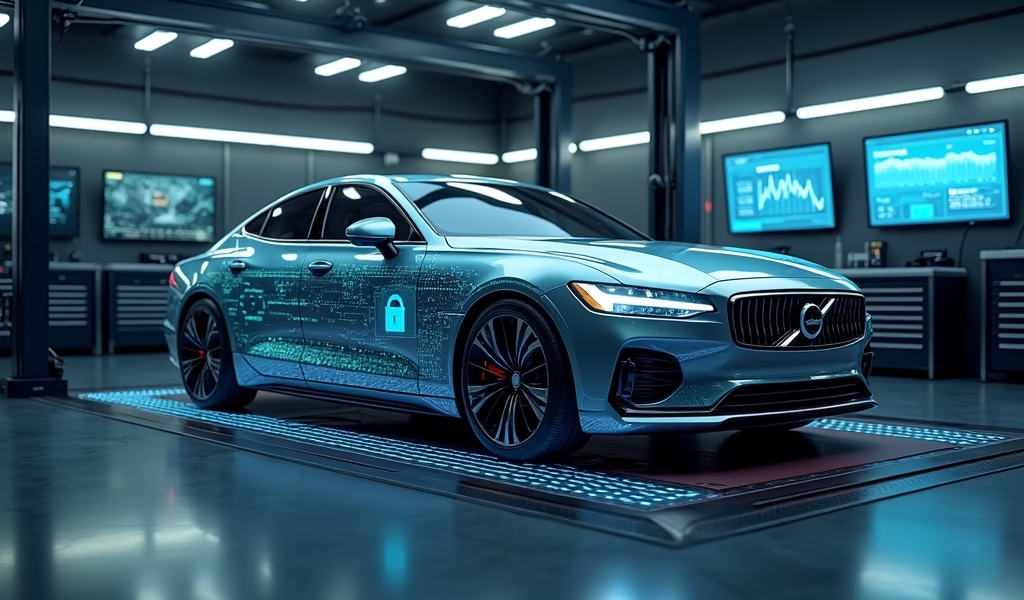Overview
This article details five essential safeguards for protecting vehicle telemetry data in modern connected cars: end-to-end encryption, secure authentication methods, regular security updates, data minimization practices, and intrusion detection systems. These protections are crucial as vehicles increasingly collect and transmit sensitive data about driving habits, location, and performance metrics, presenting both convenience benefits and significant privacy and security risks for drivers.
Table of Contents
- Understanding Car Telemetry: Your Vehicle’s Digital Heartbeat
- Safeguard #1: End-to-End Encryption – The Digital Fortress
- Safeguard #2: Secure Authentication – Your Car’s Bouncer
- Safeguard #3: Regular Security Updates – Digital Maintenance Matters
- Safeguard #4: Data Minimization – Less is More Secure
- Safeguard #5: Intrusion Detection Systems – Your Car’s Security Guard
- Conclusion: Securing Your Automotive Future
- Frequently Asked Questions
Understanding Car Telemetry: Your Vehicle’s Digital Heartbeat
Remember when cars were just mechanical beasts that growled down the road? Those days are disappearing in our rearview mirrors faster than a sports car on an open highway. Today’s vehicles are rolling computers, constantly collecting and communicating data about everything from engine performance to your driving habits and even your favorite radio stations.
Car telemetry—that silent, steady stream of data flowing from your vehicle—has transformed from a luxury feature to standard equipment in most modern vehicles. Your car whispers secrets to manufacturers, sends performance reports to technicians, and sometimes even tattles on your driving habits to insurance companies (sorry about that lead foot of yours).
As a mechanic who’s watched this transformation happen under my own wrenches, I’ve seen firsthand how telemetry can be both a blessing and a potential curse. When properly secured, this data helps us spot problems before they strand you on the highway and keeps your vehicle running at peak performance. But when left vulnerable? Well, that’s when trouble shifts into high gear.
With every new connection point comes a potential backdoor that digital troublemakers might exploit. Your connected car could become a privacy nightmare or, in worst-case scenarios, a safety hazard. (And trust me, no one wants their braking system getting hacked while cruising down the interstate—talk about a mechanic’s nightmare!)
That’s why understanding and implementing proper car safety features isn’t just important—it’s essential for automotive security in our connected world. Let’s pop the hood on the five most critical safeguards that keep your vehicle’s digital systems as secure as its physical ones.
Safeguard #1: End-to-End Encryption – The Digital Fortress
Picture your car’s data as a secret message traveling through a crowded room. Without protection, anyone could snatch it midair and read all your private information. That’s where encryption swoops in like a superhero, wrapping your data in an impenetrable code that only the intended recipient can decipher.
End-to-end encryption serves as your vehicle’s digital armor, transforming sensitive information—like your GPS location, driving patterns, or diagnostic codes—into scrambled gibberish that would leave even the most determined hackers banging their keyboards in frustration. Only authorized parties hold the special keys needed to make sense of this data.
In my 20+ years working with vehicles, I’ve seen encryption standards evolve from relatively simple codes to sophisticated algorithms that would take supercomputers years to crack. Modern encryption protocols use complex mathematical puzzles that make unauthorized access virtually impossible when implemented correctly.
Companies like Tesla have set the gold standard here, using encryption that would make government intelligence agencies nod in approval. Their vehicles encrypt communications between the car and Tesla’s servers, making it significantly harder for digital eavesdroppers to intercept your information.
The beauty of strong encryption is its silent efficiency—it works tirelessly in the background like a well-tuned engine, protecting your data without you ever needing to think about it. When shopping for a connected vehicle, asking about encryption standards is as important as inquiring about horsepower or fuel economy.
And between us gearheads—wouldn’t we all prefer that the details of our occasional “spirited driving” remain safely encrypted between us and our vehicles? (I’m not saying I’ve ever pushed my truck beyond posted limits, but those mountain roads do call my name sometimes…)

Safeguard #2: Secure Authentication – Your Car’s Bouncer
If encryption is your data’s armor, then authentication is the burly bouncer checking IDs at the door of your vehicle’s systems. Just as you wouldn’t hand your house keys to a stranger, your car shouldn’t grant access to its digital systems without properly verifying who’s knocking.
Multi-factor authentication (MFA) stands as the premier protection against unauthorized access. Rather than relying on a single password (which could be compromised faster than you can say “check engine light”), MFA demands multiple forms of verification before rolling out the red carpet to your car’s systems.
This might include:
- Something you know (a password or PIN)
- Something you have (your smartphone or key fob)
- Something you are (fingerprint or facial recognition)
- Something you do (behavior patterns like how you typically use your vehicle)
I’ve seen some clever implementations in my shop recently—vehicles that recognize not just your key fob but also your smartphone and won’t fully activate certain features until they detect your specific driving patterns. It’s like your car getting to know your personal driving “fingerprint” and refusing to perform for impostors.
The strongest authentication systems create multiple defensive layers—like the concentric walls of a medieval castle. Even if attackers breach one perimeter, additional verification requirements stand ready to stop them cold. It’s the digital equivalent of having backup brakes—something every good mechanic appreciates!
When properly implemented, these authentication safeguards dramatically reduce the risk of unauthorized access. It’s a bit like how we used to install steering wheel locks back in the day—a small effort that pays enormous dividends in security.
One quick tip from this old grease monkey: if your vehicle offers enhanced authentication options, don’t treat them as annoying extras—embrace them as essential car diagnostic security features. That extra second of verification might save you hours of headaches down the road!
Safeguard #3: Regular Security Updates – Digital Maintenance Matters
Here’s something I tell every customer who rolls into my shop: maintenance isn’t just about oil changes and tire rotations anymore. In our connected world, keeping your car’s software updated is just as crucial as changing the air filter—maybe even more so. (When was the last time a dirty air filter gave hackers access to your personal information?)
Software vulnerabilities are like tiny cracks in your engine block—they might start small, but left unaddressed, they can lead to catastrophic failure. The critical difference between a secure vehicle and a vulnerable one often comes down to how quickly these digital cracks get patched through regular updates.
Over-the-air (OTA) updates have revolutionized vehicle security by allowing manufacturers to fix security holes without requiring you to visit a service center. This capability transforms vehicles from static systems with declining security to dynamic platforms that continuously strengthen their defenses against emerging threats—kind of like an immune system that gets stronger with each new exposure.
Back in 2015, security researchers famously demonstrated how they could remotely hack a Jeep Cherokee through its infotainment system, controlling critical functions like steering and braking. This watershed moment in automotive security prompted Chrysler to issue emergency patches to millions of vehicles—underscoring both the seriousness of telemetry vulnerabilities and the crucial nature of prompt updates.
As a mechanic who’s seen the evolution of vehicle maintenance from purely mechanical to increasingly digital, I can’t stress enough how important it is to treat software updates with the same urgency as you would a brake fluid leak. Both can leave you vulnerable in different but equally concerning ways.
Some practical advice from the shop floor: never ignore update notifications from your manufacturer. These aren’t just adding fancy new features—they’re often patching security holes that could leave your vehicle exposed. And if your car doesn’t support OTA updates? Make those dealership appointments for software updates as faithfully as you would for oil changes.
Safeguard #4: Data Minimization – Less is More Secure
There’s an old saying in my shop: “You can’t lose what you don’t have.” When it comes to data collection in modern vehicles, this wisdom translates perfectly—data that doesn’t exist can’t be stolen. That’s why data minimization serves as a cornerstone of automotive telemetry security.
Think of your vehicle’s data collection like packing for a road trip. The more unnecessary items you bring along, the more you have to worry about protecting (and potentially losing). Smart manufacturers apply this same principle to telemetry, collecting only what’s truly necessary for specific purposes rather than hoarding every possible data point.
Privacy by design represents a proactive approach where privacy considerations are built into telemetry systems from the drawing board rather than tacked on as afterthoughts. This includes:
- Automatic data anonymization (stripping personally identifiable information)
- Local processing where sensitive information stays in your vehicle
- Default settings that protect privacy unless you specifically opt for more sharing
- Clear, understandable consent mechanisms that don’t require a law degree to comprehend
In my decades working on vehicles, I’ve seen the amount of data collected increase exponentially. Modern cars can track everything from your driving routes to your music preferences and even how heavily you press the accelerator. While some of this information enables helpful features, not all of it needs to leave your vehicle or be stored long-term.
The best connected vehicles today empower owners with granular control over what data is shared and with whom. Just as you wouldn’t give everyone who steps into your garage access to your personal toolbox, your vehicle shouldn’t share all its data indiscriminately.
The regulatory landscape continues to evolve, with frameworks like Europe’s GDPR and California’s CCPA establishing clearer requirements for data protection. Forward-thinking manufacturers don’t just meet these standards—they exceed them, recognizing that strong privacy protection represents both an ethical obligation and a competitive advantage.
One tip this mechanic swears by: When setting up a new vehicle, take the time to review and configure privacy settings rather than accepting all defaults. It’s like taking five minutes to adjust your mirrors properly—a small investment that significantly improves your driving experience.

Safeguard #5: Intrusion Detection Systems – Your Car’s Security Guard
Even with the best locks on your garage, you’d still want to know if someone managed to break in—and ideally stop them before they could hot-wire your pride and joy. The same principle applies to your vehicle’s digital systems through intrusion detection and prevention technologies.
Modern vehicles increasingly incorporate sophisticated monitoring systems that act like vigilant night watchmen, continuously patrolling for suspicious activities or unauthorized access attempts. These digital security guards establish baselines of normal behavior and immediately flag anomalies that might indicate someone’s trying to tamper with your vehicle’s systems.
When I explain this to customers in my shop, I often compare it to the ABS system in cars—you hope you never need it, but you’ll be mighty thankful it’s there during an emergency. Intrusion detection works similarly, remaining quietly vigilant until it spots something suspicious.
When unusual activity is detected, these systems can trigger various response protocols:
- Alerting you and the manufacturer about potential breach attempts
- Temporarily restricting certain connectivity functions
- Logging detailed information about the attempt for security analysis
- Initiating additional authentication challenges
In recent years, automotive companies have increasingly partnered with cybersecurity specialists to develop protection systems specifically designed for vehicles. These collaborations have produced technologies that can detect and respond to threats in real-time, significantly reducing the window of opportunity for potential attackers.
Looking ahead, we’re seeing artificial intelligence playing a larger role in vehicle security, with systems that learn from attempted breaches across entire fleets to strengthen protections for all vehicles. It’s like having millions of security guards comparing notes—except these guards never need coffee breaks or miss suspicious activity while checking their phones!
As someone who’s been elbow-deep in engines for decades, I find it fascinating how vehicle protection has evolved from simple alarm systems to sophisticated intrusion detection. The principles remain the same—detect threats early and respond decisively—but the implementation has become exponentially more advanced.
A piece of practical advice from this old mechanic: If your vehicle ever alerts you to suspicious activity, don’t ignore it any more than you would ignore a check engine light. Both are early warning systems designed to prevent much bigger problems down the road.
Conclusion: Securing Your Automotive Future
As we’ve seen under the digital hood, protecting your vehicle’s telemetry requires multiple layers of security working in harmony—much like how your car needs properly functioning brakes, steering, and tires to keep you safe on the road. Each safeguard addresses different vulnerabilities, creating a comprehensive defense system for your vehicle’s data.
Encryption wraps your information in protective code, authentication ensures only authorized parties gain access, regular updates patch vulnerabilities, data minimization reduces potential targets, and intrusion detection systems provide continuous monitoring. Together, they form a robust security framework that helps keep both your data and your vehicle protected.
The road ahead for connected vehicles promises exciting innovations, from fully autonomous driving to unprecedented personalization. But with these advancements come new security challenges that will require vigilance from manufacturers, service providers, and vehicle owners alike.
As a mechanic who’s witnessed the transformation from purely mechanical vehicles to computerized marvels, I believe that understanding telemetry security is becoming as essential as knowing when to change your oil. Both are fundamental maintenance issues that can prevent serious problems down the road.
Remember that security, like vehicle maintenance, works best as a partnership. Manufacturers must build secure systems and provide timely updates, service providers must handle data responsibly, and we as owners should stay informed about best practices and available protections.
So the next time you’re admiring your vehicle’s sleek lines or impressive performance, spare a thought for the invisible but critical security systems protecting its digital components. They’re working tirelessly behind the scenes to ensure that your connected car remains a source of convenience and enjoyment—never a security liability.
After all, in today’s digital age, your car knows a lot about you. Making sure that information stays private isn’t just about security—it’s about preserving your personal freedom on the open road.
Frequently Asked Questions
What exactly is car telemetry?
Car telemetry is the automated remote collection and transmission of data from your vehicle to manufacturers, service providers, or smartphone apps. This data can include everything from engine performance and vehicle location to driving habits and entertainment preferences.
Can hackers really take control of my car remotely?
Yes, in vehicles with vulnerable systems, hackers have demonstrated the ability to remotely control critical functions. This risk is precisely why implementing strong security safeguards is essential for all connected vehicles.
How often should I update my vehicle’s software?
You should install security updates immediately when they become available, just as you would on your computer or smartphone. Regular maintenance updates can typically be installed at your convenience, but shouldn’t be delayed for extended periods.
Do older cars have telemetry security concerns?
Vehicles manufactured before 2010 typically have minimal connectivity and therefore fewer telemetry security concerns. However, if you’ve added aftermarket connected devices or systems, these may introduce security vulnerabilities that require attention.
How can I check what data my car is collecting about me?
Review your vehicle’s owner manual section on data collection or privacy, check the manufacturer’s privacy policy online, and explore settings in your vehicle’s infotainment system. Many newer vehicles also provide data transparency options through their associated smartphone apps.


Pingback: Virtual Car Inspection Services Explained - knowsyourcar.com
Pingback: How Remote Car Monitoring Works: 5 Tips - knowsyourcar.com